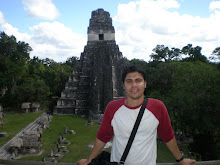
Before I left for Guatemala, I got in contact with an organization called Camino Seguro, or Safe Passage. This organization provides assistance to the families working in the Guatemala City garbage dump. They provide the children with an educational after-school program (since school is only half a day), nutritious food, access to computers and a nurturing environment. A program for mothers provides literacy classes for those who never had a chance to go to school.
While in Guatemala, I visited Safe Passage and got to meet some of the staff members and the families being served. We started out in the Safe Passage office in Antigua and drove 1 hr to the
 landfill in Guatemala City. We arrived at an outlook point where we could overlook the entire landfill. An unpleasant stench permeated the air. In the landfill, people rummaged about the garbage. Trucks came in to empty new loads of putrid refuse, and people rushed to find anything of value. The scene was quite unlike anything I had ever seen before.
landfill in Guatemala City. We arrived at an outlook point where we could overlook the entire landfill. An unpleasant stench permeated the air. In the landfill, people rummaged about the garbage. Trucks came in to empty new loads of putrid refuse, and people rushed to find anything of value. The scene was quite unlike anything I had ever seen before.Recently the students at Safe Passage were asked what their wishes were for the coming year. Some of their responses were:
- Establish an emergency food basket for students who are hungry at times when there is not enough food in the house to feed everyone
- Provide an extra toothbrush to bring home, to be able to brush their teeth over the weekends when they are not in the project
- Distribute an extra pair of shoes and sneakers during the year, since our students receive shoes at the start of the school year that are often their only pair
As you can see, these simple requests demonstrate the basic needs of these children.

It is uplifting, however,
 to learn that Safe Passage is helping these families improve their quality of life. Real progress is being made. Recently four new students recently graduated high school and are in career-development training, while eight mothers received a sixth-grade diploma through the Adult Literacy Program. The organization is providing tuition, uniforms, books and educational support for over 500 children living near the garbage dump. Lives are being changed, and the Safe Passage children can now hope for a better future.
to learn that Safe Passage is helping these families improve their quality of life. Real progress is being made. Recently four new students recently graduated high school and are in career-development training, while eight mothers received a sixth-grade diploma through the Adult Literacy Program. The organization is providing tuition, uniforms, books and educational support for over 500 children living near the garbage dump. Lives are being changed, and the Safe Passage children can now hope for a better future.I applaud all of the staff and volunteers who make great sacrifices to help the Safe Passage families. Being around this type of poverty each day is not easy to handle, yet they are in the midst of it all, devoting their time and effort to help these families.
Please take a few minutes to read about Safe Passage. If we each take one small step to help, together we can make a huge difference.

























